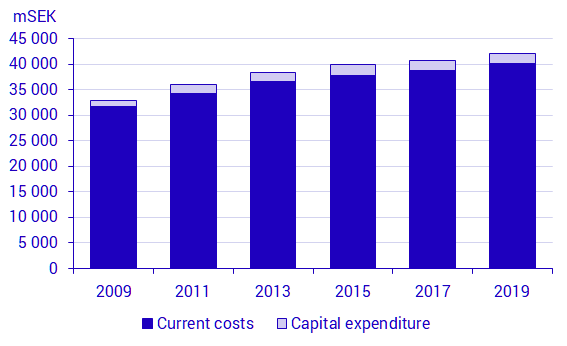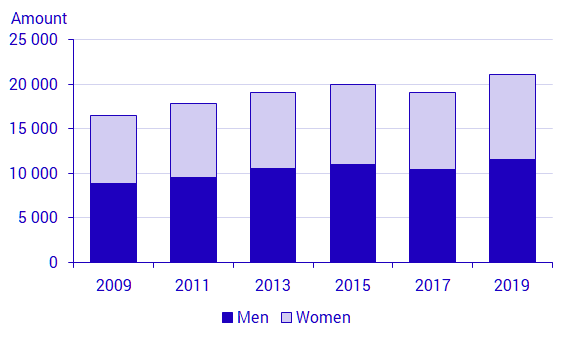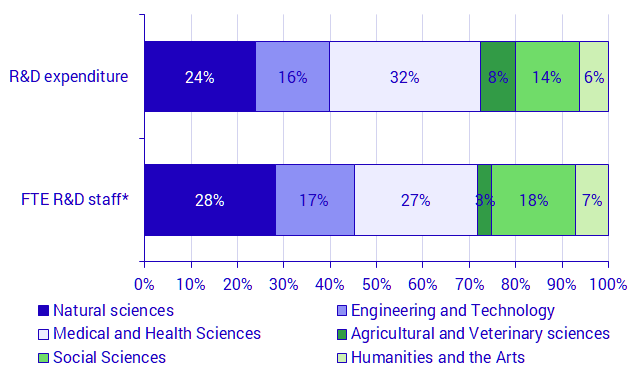R&D in Sweden 2019 – the higher education sector
Economic and staff resources have increased in higher education R&D activities
Statistical news from Statistics Sweden 2020-10-22 9.30
As in previous years, medical and health sciences, and natural sciences were the largest fields of research in terms of total expenditure and staff resources. On the other hand, in 2019, the largest increase in total expenditure was noted in agricultural and veterinary sciences, while the largest increase in staff resources was noted in natural sciences.
Economic resources
Research and development (R&D) expenditure in the higher education sector amounted to SEK 42.2 billion in 2019, which is SEK 1.4 billion more than in 2017, in fixed prices. R&D expenditure consists of current costs and investment expenditure. Current costs for R&D increased by SEK 1.4 billion, while investment expenditure decreased by SEK 27 million compared with 2017.
Appropriations accounted for the largest source of financing to R&D activities in the higher education sector. The Swedish Research Council and other private non-profit organisations in Sweden were also major sponsors. These three players together contributed 62 procent of total financing. ALF resources, that is, compensation for clinical research carried out at universities’ medical schools, amounted to SEK 1.7 billion in 2019, which is the same level as in 2017.

Staff resources
In 2019, R&D full-time equivalents (FTEs), which is a measure of the number of hours that employees worked in R&D activities, amounted to 21 080 in the higher education sector, which is 1 984 more than in 2017. Around half of this increase consisted of other research and teaching staff and doctoral students, which increased by just over 500 R&D FTEs each. However, the largest increase in percentage terms was among postdoctoral researchers, who form part of the group career development positions, 29 percent more than in 2017.
Lecturers, and associate senior lecturers and postdoctoral research fellows were the two employment categories with the lowest number of FTEs on R&D. Compared with 2017, these were the only categories to decrease slightly. Taken together, they noted a decrease of 25 FTEs on R&D.
There were 1000 R&D FTEs performed by non-employed staff, which is 100 less than in 2017. These FTEs on R&D have been decreasing since 2009. This group includes doctoral students who are financing their third-cycle studies in some way other than employment at a higher education institution, for example via scholarships.
As in previous years, men performed 55 percent and women performed 45 percent of the total number of R&D FTEs. Men spent on average 49 percent of their working hours on R&D, while the corresponding figure for women was 42 percent.

Economic resources increased in the research field agricultural and veterinary sciences
The largest increase of R&D expenditure was noted in the research field agricultural and veterinary sciences, which increased by SEK 867 million compared with 2017, in fixed prices. A major part of the increase is due to rising investments of SEK 678 million in this field of research, which corresponds to 78 percent of the total increase in this field. The increase in mainly investments rather than current costs explains why the same increase is not noted in staff resources in R&D in this field of research.
The largest fields of research, medical and health sciences, and natural sciences, are the only fields in which total expenditure decreased somewhat in 2019 compared with 2017. In these cases, the changes are also largely due to investment expenditure, although expenditure in these research fields instead decreased in 2019.
Staff resources have increased in all fields of research, although mainly in natural sciences and engineering and technology. FTEs on R&D increased by 727 in natural sciences and by 469 in engineering and technology. Taken together, the increase in these two fields of research correspond to 60 percent of the total increase in FTEs on R&D.
The smallest increase in R&D FTEs was noted in agricultural and veterinary sciences, as well as in the group without any specific research subject area. Taken together, these groups increased by 40 R&D FTEs.

*Not including R&D FTEs carried out without any field of research.
Definitions and explanations
FTEs
One full-time equivalent R&D is defined as the number of hours conventionally worked by a full-time employee over one year. Thus, a full-time employee who devotes 50 percent of their working hours on R&D carries out 0.5 FTE on R&D. One person can never perform more than one FTE, even if the person works overtime.
Employment categories
In the current survey, staff at universities and institutes of higher education are presented by employment category rather than service category. The nine categories are
Professors
Career development positions
- of whom are postdoctoral researchers
- of whom associate senior lecturers and postdoctoral research fellows
Senior lecturers
Lecturers
Other research or teaching staff
Doctoral students
Administrative staff and technical staff
ALF funds reporting
ALF refers to an agreement between central government and seven regions concerning medical training and research that regulates the amount of central government compensation for the regions commitment to participate in medical education, conduct clinically oriented medical research, and develop health and medical care. Although central government issues compensation via universities, economic reporting is to be done by the regions.
Statistical Database
More information is available in the Statistical Database
Feel free to use the facts from this statistical news but remember to state Source: Statistics Sweden.
